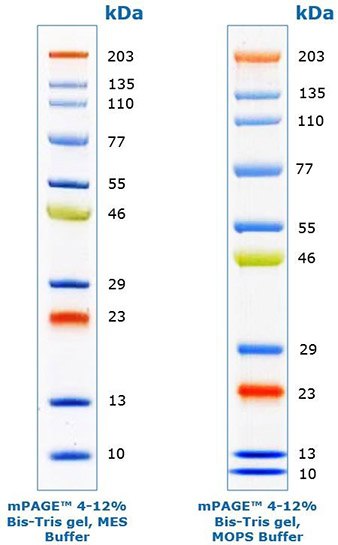Protein Markers
![Migration differences of mPAGE Color Protein Standard on 12% gel chemistries (kDa) The chart displays molecular weight (kDa) differences of mPAGE® Color Protein Standard when separated on different gel chemistries. The mPAGE® Color Protein Standard consists of 10 colored bands. Migration patterns and apparent molecular weight for 4 gel chemistries are displayed, mPAGE® Bis Tris precast gels, mPAGE® LUX Bis-Tris, mPAGE® TurboMix Bis-Tris and Tris-Glycine. The apparent molecular weight for all Bis-Tris gel chemistries is presented for MOPS and MES running buffer. Separation ranges and apparent molecular weight for the Color Protein Standard are dependent on the gel chemistry and running buffer choice; mPAGE® precast gel with MOPS Running Buffer [242kDa-10kDa], mPAGE® precast gel with MES Running Buffer [257kDa-10kDa], mPAGE® LUX handcast gel with MOPS Running Buffer [288kDa-10kDa], mPAGE® LUX handcast gel with MES Running Buffer [291kDa-10kDa], mPAGE® TurboMix handcast gel with MOPS Running Buffer [259kDa-10kDa], mPAGE® TurboMix handcast gel with MES Running Buffer [275kDa-10kDa], and Tris-Glycine handcast gels with Tris-Glycine Buffer [259-10kDa]. Color Protein Standard separated on Bis-Tris gels using MOPS running buffer typically migrate further into the gel than with MES running buffer for a given gel chemistry. For most accurate molecular weight calculation always utilize a unstained molecular weight marker.](/deepweb/assets/sigmaaldrich/marketing/global/images/categories/protein-electrophoresis-and-western-blotting/migration-differences/migration-differences.jpg)
Migration differences of mPAGE® Color Protein Standard on 12% gel chemistries (kDa)
Protein molecular weight markers, sometimes referred to as protein standards or protein ladders, are used to estimate the molecular weight of proteins of interest and to monitor the progress of electrophoretic separation or transfer in Western blotting. Unstained molecular weight markers usually consist of a mixture of purified native or recombinant proteins of defined molecular weights. Visualizing their location on a gel or membrane requires a staining step. Pre-stained protein markers allow easy tracking of electrophoretic separation and transfer efficiency. Individual protein standards are also available for protein electrophoresis, isoelectric focusing, and 2D-PAGE applications.
Products

mPAGE® Color Protein Standards
mPAGE® Protein Standards
- mPAGE® Western Protein Standards consist of seven recombinant proteins at 20 kDa, 30 kDa, 40 kDa, 50 kDa, 60 kDa, 80 kDa and 120 kDa with an IgG binding site that binds to most antibodies. This enables visualization of both the protein marker and sample proteins on the same western blot without additional reagents.
- mPAGE® Color Protein Standards include a mixture of ten highly purified pre-stained proteins ranging from 10 kDa to 203 kDa, covalently coupled with different chromophores. mPAGE® Color Protein Standards are designed for observing protein separation during SDS-PAGE, verifying Western blotting transfer efficiency on membranes, and approximating the size of proteins.
- mPAGE® Unstained Protein Standards include a mixture of twelve recombinant unstained proteins ranging from 10 kDa to 200 kDa. The 85 kDa, 25 kDa, and 10 kDa bands have higher intensity to serve as reference points. mPAGE® Unstained Protein Standards are suitable for molecular weight determination after SDS-PAGE or Western blotting and serves as standards to calibrate the mobility of pre-stained markers.

BLUeye Prestained Protein Ladders

ColorBurst™ Protein Markers
ColorBurst™ Protein Markers
ColorBurst™ Markers are composed of eight polypeptides that have been chemically reduced and conjugated to brilliantly colored dyes. ColorBurst™ markers can be used to estimate sample molecular weights, monitor the progress of an electrophoretic run, or confirm completion of electroblotting.
SigmaMarker™ Protein Markers
SigmaMarker™ protein markers are designed for use with SDS-PAGE and cover the range of molecular weights common to most proteins or their subunits. These high and low wide range markers are lyophilized with sample buffer so that they are ready-to-use after reconstitution with deionized water. The markers are formulated to yield a distribution of well-defined bands of approximately equal intensity after electrophoresis and Coomassie blue staining.

Ultra-low Range Protein Markers
Perfect Protein Markers
Perfect Protein Markers were designed for routine use in SDS-PAGE to enable highly accurate size determination of unknown samples. Unlike many conventional markers (e.g., ovalbumin, serum albumin), Perfect Protein Markers contain no oligosaccharides that cause anomalous migration, heterogeneous "fuzzy" bands, or inaccurate size estimation. These markers are optimized for use with Coomassie blue staining, but adjusted amounts can also be used with other gel staining methods including silver staining and staining with fluorescent dyes.
Ultra-low Range Protein Markers
Ultra-low Range Molecular Weight Markers (M.W. 1,060-26,600 Da) have been used as protein markers in SDS-PAGE and Western blotting. Fixing is recommended.
Non-denaturing Protein Markers
Non-denaturing markers have been used as standards for native PAGE, as well as to calibrate columns for gel exclusion chromatography.
Biotinylated Markers
The Biotinylated Molecular Weight Standard Mixture contains proteins that are biotin-conjugated for use as both SDS-PAGE standards and as standards for Western blotting. Visualization is accomplished using streptavidin-peroxidase with an appropriate colorimetric or luminescent substrate. These markers can be detected simultaneously with immunostaining procedures.
Related Resources
- Handbook: Protein Blotting Tips and Tricks
This handbook represents the collective experience of our application scientists, who are actively engaged in advancing the science of protein blotting and detection.
- Brochure: Rethink Western Blotting
Explore our products designed to improve each step of the Western blotting workflow.
To continue reading please sign in or create an account.
Don't Have An Account?